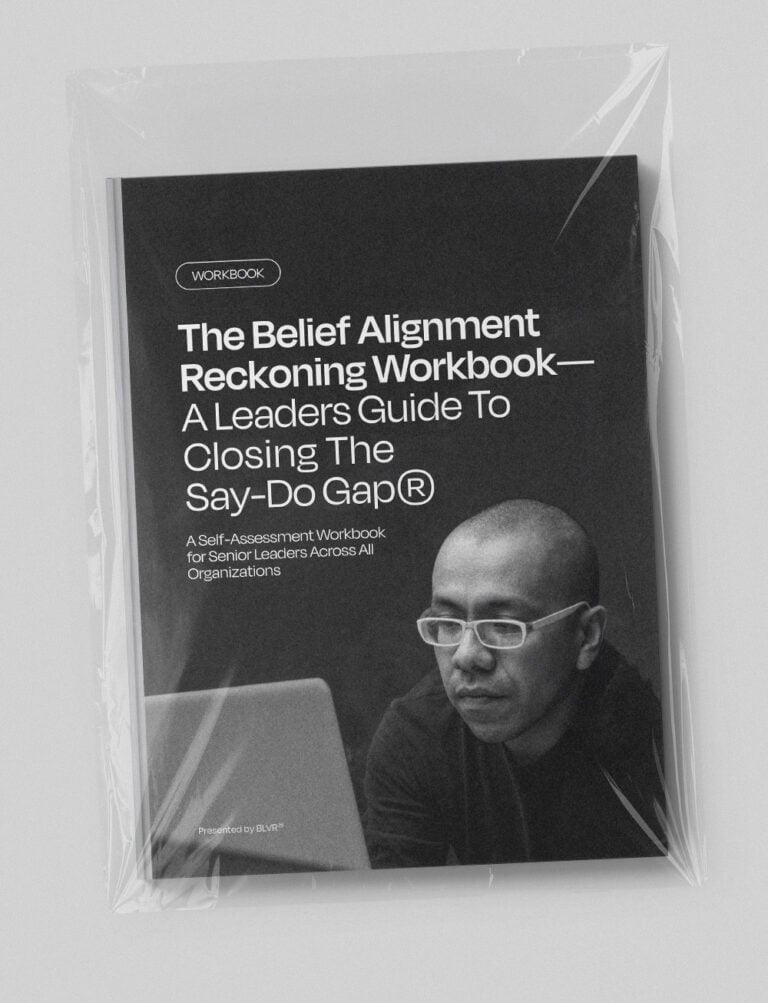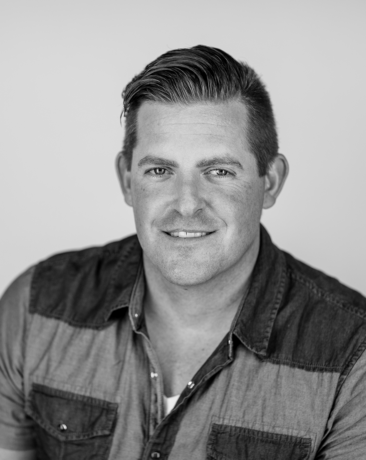
Business Branding / BY Scott Hancock
You’re Not Stuck – Your Scared: Lead With Belief, Not Fear
Published On 01.21.2025
Article
Introduction: The Fear That Keeps You Stuck
Your brand wasn’t built to blend in—it was built to lead, challenge, and disrupt. From the start, you had a vision bigger than selling a product. You wanted to create a legacy, ignite loyalty, and inspire belief. But somewhere along the way, hesitation crept in.
Momentum turned into maintenance. Growth became comfort. And now, instead of leading boldly, you feel stuck.
Let’s get real: you’re not stuck—you’re scared.
Fear doesn’t announce itself with fanfare. It whispers:
- “Change is too risky.”
- “What if we lose what we’ve built?”
- “What if we fail?”
Fear convinces you that standing still is the safest choice. But in today’s hyper-competitive, trust-driven world, staying put is the riskiest move of all.
Why This Matters
Customers: They’re not looking for polished marketing. They want proof. They expect to see your belief in action, not just hear about it.
Employees: They’re hungry for leadership that’s bold, authentic, and aligned with purpose.
Competitors: They’re moving fast, taking risks, and seizing the opportunities you hesitate to pursue.
The gap between what you say you stand for and what you actually deliver—the Say-Do Gap®—is where trust is lost. Every time fear takes over, that gap widens, making it harder to inspire loyalty, drive innovation, or stay relevant.
The Opportunity
Fear doesn’t have to win. You don’t need to chase trends or patch cracks with quick fixes. What you need is to reconnect with the bold belief your brand was built on and align your actions with that purpose.
This isn’t about being perfect—it’s about being fearless.
Ask Yourself:
- What would your leadership look like if fear weren’t in control?
- What bold action could your brand take if belief, not hesitation, led the way?
Chapter 1: The Myth of Being Too Big (or Small) to Change
The Comfort Trap
Building a brand is no small feat. It takes grit, sacrifice, and relentless focus. After years of effort, it’s natural to want to protect what you’ve built.
But here’s the truth: comfort isn’t strategy—it’s stagnation.
You tell yourself:
- “We’re too big to risk disruption now.”
- “What if we lose everything by changing too much?”
- “Let’s stick with what we know—it’s safer.”
But comfort is a slow killer. While you cling to the familiar:
- Customers disengage: They crave bold, belief-driven brands that evolve with them.
- Employees lose morale: A stagnant mission creates a stagnant culture.
- Competitors seize momentum: They innovate while you hesitate.
“Staying stuck isn’t safe—it’s surrender. Fear doesn’t protect your brand; it paralyzes it.”
The Real Cost of Inaction
Fear has a steep price tag. Here’s what’s at stake:
- Lost Relevance: Customers won’t stay loyal to brands that feel outdated or uninspired.
- Eroded Trust: Every inconsistency between your promises and actions widens the Say-Do Gap®, making trust harder to rebuild.
- Missed Growth Opportunities: While competitors innovate boldly, you risk falling behind.
ROI Perspective:
- Brands that close the Say-Do Gap® experience higher loyalty, stronger retention, and lower customer acquisition costs. Even a 5% boost in retention can increase profits by 25-95%.
- Conversely, brands that hesitate face skyrocketing acquisition costs and dwindling loyalty.
Case Study: Liquid Death—Rejecting Comfort and Winning Big
When Liquid Death entered the bottled water market, the odds were stacked against them. The space was overcrowded with predictable, wellness-focused branding. Most brands would have played it safe.
Liquid Death didn’t. Instead, they leaned into their belief: Water doesn’t have to be boring.
Here’s how they disrupted an entire industry:
- Rebellion as Strategy: Their punk-rock branding and irreverent humor transformed hydration into rebellion.
- Building a Movement: They didn’t just sell water—they created a cult following of fans who shared their ethos.
If Liquid Death had followed conventional wisdom, they’d be just another name in a saturated market. Instead, they’re proof that bold belief can turn a simple product into a movement.
Reframing the Risk
The greatest risk isn’t change—it’s staying the same.
Every day you hesitate to act, you miss opportunities to:
- Deepen Trust: Align your actions with belief to inspire loyalty.
- Ignite Passion: Bold decisions re-energize employees and foster innovation.
- Outpace Competitors: While others take risks, your hesitation leaves you vulnerable.
Ask Yourself:
- What would your brand look like if fear didn’t hold you back?
- If customers analyzed your decisions, would they see conviction—or hesitation?
“The question isn’t whether your brand will change—it’s whether you’ll lead that change or be left behind.”
Key Takeaway: The Myth of Being Too Big (or Small) to Change
Comfort isn’t a shield—it’s a slow death. Fear convinces you that staying the same is the safest choice, but inaction is the riskiest move of all. Brands like Liquid Death show that bold belief, not cautious maintenance, wins trust, relevance, and growth. The time to disrupt your comfort zone is now, because the cost of inaction is greater than any risk of bold change.
Chapter 2: Fear vs. Belief—What’s Driving Your Decisions?
Two Forces Behind Every Decision
Every decision you make as a leader is powered by one of two forces: fear or belief.
- Fear whispers, “What if this goes wrong?” It prioritizes caution, safety, and short-term wins.
- Belief asks, “What if this is what changes everything?” It prioritizes conviction, purpose, and long-term trust.
The challenge isn’t that fear exists—it always will. The real question is which force drives your leadership: fear or belief?
Let’s dig deeper.
The Trap of Fear-Driven Leadership
Fear rarely announces itself boldly. Instead, it disguises itself as practicality or “common sense.” It says things like:
- “We don’t want to alienate anyone with this idea.”
- “Let’s wait until we’re absolutely sure.”
- “What if this campaign backfires?”
Fear convinces you that playing it safe is the smartest choice. But here’s the truth: playing it safe comes at a cost.
The Costs of Fear-Driven Decisions:
- Eroded Trust: Fear leads to hesitation, and hesitation signals misalignment. Customers sense when a brand is unsure of itself, and that doubt erodes trust.
- Missed Opportunities: While you wait for certainty, competitors are leaping ahead. Fear-driven brands lose relevance in fast-moving markets.
- Diluted Identity: Playing it safe makes your brand forgettable—a shadow of the bold vision it was meant to be.
“Fear shrinks your brand with every decision. Belief builds it, one bold action at a time.”
Case Study: Better Place Forests—Purpose Over Fear
Better Place Forests, a disruptor in the funeral industry, faced a monumental challenge: How do you reinvent an industry steeped in tradition? Their answer: with belief.
Their core belief: End-of-life experiences should honor the environment and celebrate life.
Here’s how they rejected fear and leaned into conviction:
- Challenging Tradition: They introduced memorial forests as a sustainable, meaningful alternative to cemeteries and cremation.
- Prioritizing Purpose Over Profit: Rather than appealing to everyone, they focused on purpose-driven customers who shared their belief in environmental legacy.
- Educating the Market: Despite initial skepticism, they leaned into educating consumers about their offering rather than watering it down for mass appeal.
The Result: Better Place Forests didn’t just create a product—they built a movement. By staying aligned with their belief, they redefined their industry and built trust with a deeply loyal audience.
The Power of Belief-Driven Leadership
Belief-driven leadership isn’t just a mindset—it’s an actionable commitment to align every decision with your brand’s core belief. Leaders who lead with belief:
- Act with Conviction: They make bold decisions, even when uncomfortable or unpopular.
- Inspire Loyalty: Customers and employees rally behind brands that live their beliefs unapologetically.
- Drive Transformation: They don’t just compete—they redefine markets.
Case Study: Rylee + Cru—Rejecting Fast Fashion
Rylee + Cru, a children’s clothing brand, operates on a powerful belief: Kids deserve clothing that balances artistry, comfort, and responsibility.
Here’s how they embraced belief-driven leadership:
- Rejecting Fast Fashion: They prioritized timeless, intentional designs over fleeting trends.
- Living Their Belief: Sustainability and ethical sourcing weren’t buzzwords—they were non-negotiables at every level of production.
- Building a Community: They fostered loyalty among parents who valued thoughtful, meaningful design.
The Result: Rylee + Cru didn’t just sell clothes—they built a movement of families who share their belief in artistry and sustainability.
“Belief-driven brands don’t just survive—they lead. They inspire trust, loyalty, and transformation.”
Reframing Risk Through Belief
Fear magnifies the risks of bold decisions while minimizing the risks of standing still. But the reality is this: staying stuck is the riskiest move of all.
When you lead with belief:
- You Close the Say-Do Gap®: Customers see your actions align with your promises, and trust deepens.
- You Ignite Employee Passion: A clear, conviction-driven mission energizes your team.
- You Outpace Competitors: Bold decisions create momentum that hesitant brands can’t replicate.
Reflection Questions for Leaders
- Where is fear holding your brand back?
- Are your decisions driven by belief—or by a desire to avoid risk?
- If your customers analyzed your recent actions, would they see conviction or hesitation?
“The boldest leaders ask, ‘What would we do if fear weren’t in the equation?’ Then they do it.”
Key Takeaway: Chapter 2 – Fear vs. Belief: What’s Driving Your Decisions?
Every decision you make as a leader is powered by either fear or belief. Fear shrinks your brand and makes it forgettable. Belief builds it into a force that inspires trust, loyalty, and transformation. Brands like Better Place Forests and Rylee + Cru prove that belief-driven leadership doesn’t just help you survive—it helps you lead. The boldest leaders ask: ‘What would we do if fear weren’t holding us back?’ Then they do it.
Chapter 3: Bridging the Say-Do Gap®—Aligning Belief with Action
The Say-Do Gap®: A Trust Killer
Your brand’s success hinges on trust. But trust doesn’t live in what you promise; it lives in what you deliver.
The Say-Do Gap®—the space between what your brand says and what it does—is where trust is built or broken. When your actions don’t align with your beliefs, customers notice. Employees notice. Competitors notice.
And every instance of misalignment widens the gap.
Why Closing the Say-Do Gap® Matters
Lost Trust is Expensive:
- 67% of consumers say they won’t return to a brand they don’t trust.
Misalignment Hurts Everyone:
- Customers turn to competitors.
- Employees lose motivation.
- Investors question your long-term strategy.
But here’s the good news: Closing the Say-Do Gap® is possible, and it starts with alignment—between belief, strategy, and action.
“Trust is earned through action, not promises. Closing the Say-Do Gap® proves you’re worth believing in.”
Step 1: Reconnect with Your Core Belief
Your core belief isn’t a tagline or marketing buzzword—it’s the foundation of your brand’s existence. Everything flows from this belief, but over time, misalignment can creep in.
Ask Yourself:
- Why does our brand exist beyond profit?
- What values are non-negotiable?
- If we disappeared tomorrow, what would our customers and employees truly miss?
Step 2: Conduct a Fear Audit
Fear often disguises itself as practicality. A Fear Audit uncovers where hesitation is driving decisions instead of conviction.
How to Conduct a Fear Audit:
- Identify Fear-Driven Decisions: Look at recent actions—were they motivated by a fear of losing revenue, alienating stakeholders, or avoiding risk?
- Spot Misalignment: For each decision, ask: Did this align with our belief?
- Imagine Bold Alternatives: If fear weren’t in the equation, what would we have done differently?
“Fear widens the gap. Bold action closes it.”
Step 3: Start Small, but Start Fearlessly
You don’t need to overhaul your entire brand overnight. The key is to take one visible, belief-driven action to demonstrate alignment and prove your conviction.
How to Begin:
- Choose a Visible Action: Identify a key area of misalignment and address it boldly.
- Communicate Transparently: Customers don’t expect perfection—they expect honesty. Share your journey, including the challenges.
- Celebrate Progress: Define metrics to track alignment, and celebrate milestones.
Case Study: Allbirds—Transparency Builds Trust
Allbirds, committed to sustainability, decided to label every product with its carbon footprint.
Why? Because their belief in environmental responsibility demanded transparency. Instead of waiting for perfection, they acted boldly, owning their imperfections and inviting customers into their journey.
The Result:
Allbirds proved that small, visible steps toward alignment build credibility and inspire trust.
“You don’t have to fix everything today, but you do have to start.”
Key Takeaway: Bridging the Say-Do Gap®: Aligning Belief with Action
The Say-Do Gap® is where trust erodes—and fear is what keeps that gap wide open. Closing it begins with bold, belief-driven action that proves you’re worth believing in. Start by reconnecting with your core belief, auditing fear-driven decisions, and taking visible steps toward alignment. Brands like Allbirds demonstrate that even small, transparent actions inspire lasting trust. You don’t have to fix everything today, but you do have to start.
Chapter 4: Fearless Leadership in Action
Fearless Leadership Starts with Bold Decisions
Leadership isn’t about avoiding failure—it’s about having the courage to act boldly, even when the path forward feels uncertain. Fearless leaders recognize that belief isn’t just something you say—it’s something you live.
This kind of leadership doesn’t just transform brands; it builds movements. When you lead with conviction, you inspire trust, loyalty, and action that extend far beyond your products or services.
“Fearless leaders don’t wait for perfect conditions—they act, inspire, and redefine what’s possible.”
The High Stakes of Leadership Misalignment
When leadership fails to align with the brand’s belief, it creates a ripple effect:
- Eroded Trust: Employees and customers see through inauthenticity. Misaligned leadership makes promises ring hollow.
- Internal Frustration: Teams lose morale and motivation when their leaders don’t embody the values they’re expected to uphold.
- Stagnation: Bold action starts at the top. Hesitant leadership creates a culture of fear and inaction.
True alignment starts with leaders who model belief-driven action at every level.
Embrace Discomfort—The Catalyst for Transformation
Fearless leadership requires stepping into the uncomfortable. It’s making the hard calls, knowing some decisions might be unpopular or risky. But discomfort is where transformation happens.
Ask Yourself:
- Are you avoiding bold moves because they feel uncertain or risky?
- When was the last time you made a decision that aligned with belief, even if it came at a cost?
Case Study: Patagonia—Belief as Business Strategy
Patagonia is a masterclass in fearless leadership. Its founder, Yvon Chouinard, famously said:
“Profit is not the goal, because if it’s the goal, it’s going to corrupt everything you do.”
Here’s how Patagonia’s leadership has consistently turned belief into action:
- Radical Advocacy: From donating profits to environmental causes to closing stores during climate strikes, Patagonia embodies its belief in sustainability.
- Bold Messaging: Their “Don’t Buy This Jacket” campaign challenged consumers to rethink consumption—a message that aligned with their environmental mission.
- Long-Term Commitment: Most recently, the company transferred ownership to a trust dedicated to combating climate change, ensuring their belief drives decisions for generations to come.
The Result: Patagonia isn’t just a brand—it’s a movement. By fearlessly aligning every decision with their belief, they’ve built an unshakable bond with customers and employees alike.
Rally People Around a Purpose
Leadership isn’t just about making decisions—it’s about rallying your team, customers, and community around a shared purpose. When people believe in your mission, they become advocates, amplifying your message far beyond what you could do alone.
Example: Nike
Nike doesn’t just sell shoes—it sells courage, equality, and perseverance. Through campaigns like “Just Do It” and athlete-driven storytelling, Nike rallies global audiences around its core belief: If you have a body, you’re an athlete.
Ask Yourself:
- Does your leadership inspire your team to embrace and live out your belief?
- How can you rally customers and employees around your brand’s purpose?
Commit to Vision Over Short-Term Wins
Fearless leaders don’t chase quarterly targets at the expense of long-term vision. They prioritize what matters: authenticity, alignment, and belief.
Example: Who Gives A Crap
This sustainable toilet paper company donates 50% of profits to clean water initiatives. Their humor-driven marketing and bold actions reinforce their belief that even mundane products can create a global impact.
The Result: Customers don’t just buy their products—they buy into their purpose, driving loyalty and advocacy.
“Fearless leaders play the long game. They prioritize legacy over quick wins, belief over convenience.”
Step 1: Embody the Belief
Leadership alignment starts at the top. If leaders don’t live the brand’s belief every day, no one else will.
How to Embody Belief as a Leader:
- Walk the Talk: Make sure every decision, big or small, reflects the brand’s core belief.
- Be Transparent: Share your reasoning and intentions, even when decisions are tough. Customers and employees value honesty over perfection.
- Model Behavior: Show your team what belief-driven action looks like in practice.
Example: Chobani
Chobani’s leadership didn’t just preach inclusion—they gave 10% of the company’s equity to employees, proving their belief in uplifting everyone involved.
Step 2: Turn Belief Into Action
Fearless leadership means acting decisively on your belief, even when it feels risky.
How to Take Bold Action:
- Identify High-Impact Areas: Start with decisions that will have the most visible impact on customers and employees.
- Communicate the Why: Explain how each decision aligns with your brand’s belief to build trust and credibility.
- Take a Stand: Whether it’s environmental advocacy or ethical sourcing, use your brand as a platform for change.
Case Study: Andis—Reimagining Legacy with Purpose
Andis, a century-old grooming brand, leaned into their belief that grooming is a form of self-expression. Here’s how:
- Purpose-Driven Rebranding: Their “Create Your Way” campaign reframed grooming tools as instruments of artistry and creativity.
- Empowering Creators: Andis invested in barbers and stylists, helping them elevate their craft.
- Innovative Products: They designed versatile tools to support both professionals and enthusiasts.
The Result: Andis transformed into a lifestyle brand, inspiring loyalty and attracting a passionate community of creators.
Reflection Questions for Leaders
- What bold action can you take today to align your leadership with your belief?
- How can you empower your team and community to champion your purpose?
- What legacy do you want to leave behind?
Key Takeaway: Fearless Leadership in Action
Fearless leadership isn’t about avoiding risk—it’s about embracing discomfort, acting with conviction, and rallying people around your belief. Leaders like Patagonia’s Yvon Chouinard didn’t just set bold visions—they lived them unapologetically, redefining industries along the way. If you want to inspire loyalty, drive transformation, and build a legacy, there’s only one path forward: Lead boldly, or risk being forgotten.
Chapter 5: From Belief to Action—The Alignment Framework
Turning Belief Into Action
Belief is powerful, but belief alone isn’t enough. To build trust, inspire loyalty, and drive sustainable growth, your belief must be turned into action. Every decision, campaign, and product must align with your brand’s core belief, creating consistency and trust at every touchpoint.
The Alignment Framework provides a practical roadmap for turning belief into measurable, impactful action. When followed, it ensures that your brand lives up to its promises, closes the Say-Do Gap®, and creates lasting impact.
Step 1: Define Your Core Belief
Your belief is the foundation of your brand—the unshakable truth that drives your purpose, vision, and values. Without clarity on your belief, every decision becomes a gamble.
Ask Yourself:
- What is the deeper purpose behind our brand?
- What core truth drives everything we do?
- What would our customers, employees, and stakeholders miss most if we disappeared tomorrow?
Example: Nike
Nike’s belief, “If you have a body, you’re an athlete,” is the bedrock of their brand. This belief drives everything from product development to global campaigns, ensuring every action aligns with their purpose.
Step 2: Translate Belief Into Purpose
Purpose is belief in action—it’s how your brand makes an impact on customers, employees, and the world. It answers the question, “What do we do because of what we believe?”
How to Activate Your Purpose:
- Align your belief with the needs of your audience.
- Ensure your purpose drives value for customers and inspires employees.
- Use your purpose to guide business decisions, from product launches to marketing campaigns.
Example: Dove
Dove’s purpose, “To redefine beauty standards and help everyone experience beauty positively,” comes from their belief that beauty should be a source of confidence, not anxiety. This purpose drives their campaigns, such as the Real Beauty Project, and their inclusive product designs.
Step 3: Commit to Visionary Leadership
A belief-driven brand doesn’t just react to the present—it creates a vision for the future. Visionary leadership means making bold decisions that prioritize long-term impact over short-term wins.
Ask Yourself:
- What future does our belief shape?
- How does our vision inspire bold, belief-driven decisions?
- Are we prioritizing long-term alignment over immediate convenience?
Example: Patagonia
Patagonia’s vision isn’t just about selling outdoor gear—it’s about protecting the planet. By transferring ownership to a trust and nonprofit focused on climate action, Patagonia ensures that every decision advances their vision of environmental stewardship.
Pull Quote:
“Visionary leaders don’t just predict the future—they shape it through belief-driven action.”
Step 4: Embed Values Into Every Decision
Your values are the guardrails that keep your brand aligned with its belief. They ensure that every decision, big or small, reflects your core purpose and reinforces trust.
How to Operationalize Your Values:
- Evaluate every initiative through the lens of your values.
- Create systems and processes to hold leaders and teams accountable.
- Reward behaviors that align with your values and belief.
Example: Dr. Bronner’s
Dr. Bronner’s values—fairness, sustainability, and social equity—are embedded in every aspect of their business. From using fair-trade ingredients to capping executive pay, every decision reflects their commitment to their belief that business should be a force for good.
“Values aren’t just ideals—they’re the foundation for every action your brand takes.”
Step 5: Measure and Communicate Consistency
Alignment isn’t a one-time effort—it’s an ongoing commitment. Measuring and communicating your progress ensures that your actions consistently reflect your belief and builds trust with your audience.
How to Measure Alignment:
- Define Metrics: Track metrics like customer loyalty, employee engagement, and operational efficiency to ensure alignment.
- Conduct Regular Audits: Evaluate where your actions may have drifted from your belief and recalibrate.
- Share Progress Transparently: Customers don’t expect perfection—they expect honesty. Be open about your challenges and progress.
Example: Allbirds
Allbirds’ commitment to sustainability includes measuring their carbon footprint for every product and sharing that information transparently with customers. By owning their imperfections, they inspire trust and encourage others to join their journey.
The Alignment Framework in Action
When belief, purpose, vision, values, and actions are aligned, the impact is transformative:
- Improved Internal Culture: Employees connect deeply with your brand’s mission, leading to higher engagement and retention.
- Enhanced Customer Trust: Customers see your belief in action, creating loyalty and advocacy.
- Sustainable Growth: Belief-driven actions resonate with stakeholders, building long-term success.
- Stronger Market Position: A unified, belief-driven brand stands out in crowded markets.
Case Study: Who Gives A Crap—Alignment Through Action
Who Gives A Crap’s belief in sustainability drives every aspect of their brand:
- Purpose: Donating 50% of profits to clean water initiatives aligns with their mission.
- Values: Humor and transparency define their customer communication, making their purpose relatable and engaging.
- Action: They use sustainable materials and bold marketing campaigns to live out their belief daily.
The Result: By aligning their belief with their actions, Who Gives A Crap inspires deep customer loyalty and advocacy.
Reflection Questions for Leaders
- Is your belief clearly defined, and does it guide every action your brand takes?
- Are your leadership decisions aligned with your vision and purpose?
- How do your values show up in your day-to-day operations?
“Alignment isn’t about being perfect—it’s about being consistent, honest, and bold in living your belief.”
Key Takeaway: From Belief to Action: The Alignment Framework
Belief alone isn’t enough—it must be operationalized. The Alignment Framework turns your belief into measurable action, embedding it into every decision, campaign, and process. Brands like Nike, Dove, and Who Gives A Crap show that alignment isn’t just a moral choice—it’s a competitive advantage that drives trust, loyalty, and growth. Alignment isn’t about being perfect—it’s about being bold, honest, and consistent.
Conclusion: The Courage to Begin
Fearless Leadership Starts Today
The greatest challenge of leadership isn’t fear—it’s letting fear dictate your decisions. True leadership begins with courage—the courage to act boldly, even in the face of uncertainty, and to align every decision with your belief.
Fear will always whisper:
- “What if it’s too risky?”
- “What if we fail?”
But belief asks a more powerful question:
- “What if this is the decision that changes everything?”
Every bold move begins with one small, fearless step.
The Cost of Inaction
Standing still isn’t safe—it’s surrender. The market is evolving. Competitors are taking risks. Customers and employees are looking for leadership rooted in authenticity and action.
Here’s what’s at stake if you let fear win:
- Lost Customers: Consumers demand proof of your belief through action, not promises. Without alignment, trust will erode.
- Disengaged Employees: Misaligned leadership creates a stagnant culture, draining passion and innovation.
- Missed Opportunities: While competitors lean into bold moves, hesitation leaves your brand trailing behind.
The Opportunity Ahead
Fearless leaders turn belief into action, building trust, inspiring loyalty, and creating movements that transcend products. The brands we admire today—Patagonia, Nike, Dove, Allbirds—didn’t succeed by playing it safe. They embraced discomfort, leaned into their beliefs, and led with conviction.
Your brand can do the same.
“The boldest leaders don’t wait for permission—they act, inspire, and redefine what’s possible.”
Your Next Steps
Building a belief-driven brand isn’t about perfection—it’s about progress. Start where you are, take one bold step forward, and commit to the journey.
Here’s how to begin:
- Reconnect with Your Belief: Revisit your brand’s purpose and ensure it’s clear, authentic, and actionable.
- Audit Your Actions: Identify where fear is holding you back or where your decisions don’t align with your belief.
- Take Visible Action: Choose one key area of misalignment and make a bold, measurable change that proves your conviction.
Your Legacy Awaits
As a leader, every decision you make shapes your legacy. Will yours be defined by hesitation or by bold, fearless action? Will your brand be remembered for playing it safe—or for leading with belief?
The time to act is now. The market is watching. Your employees are waiting. Your customers are ready for a brand that doesn’t just say what it believes—but proves it through fearless leadership.
Pull Quote:
“Fearless leadership isn’t about waiting for perfect conditions—it’s about building a legacy through bold belief.”
The Final Challenge
Ask yourself:
- What is one bold decision I can make today to align my brand with its belief?
- How will I inspire my team to act with conviction?
- What legacy do I want my leadership to leave behind?
The world doesn’t need another brand making empty promises. It needs leaders willing to close the Say-Do Gap®, turn belief into action, and create lasting change.
Now is the time to lead. Now is the time to act. Your legacy begins today.
IS YOUR BRAND BUILT ON CONVICTION OR CONVENIENCE?
Most brands talk about purpose.
Few are willing to pay the price for it.
This 45-minute assessment will reveal the hidden contradictions costing you customer trust, team alignment, and market authenticity. Discover where your beliefs and actions diverge—and get the practical framework to close the gap that’s holding your brand back.

About the Author

Scott Hancock
Partner / CEO
Scott Hancock is a thought leader in belief-driven branding and an expert in closing the Say-Do Gap®—the critical divide between what brands say and what they actually do. As CEO of BLVR®, Scott has pioneered a belief-led approach that helps organizations transform their core conviction into bold actions that inspire trust, loyalty, and market leadership.
With a reputation for pushing brands to go beyond surface-level promises, Scott’s work has been recognized by AdWeek, Forbes, and Fast Company for its fearless creativity and impactful results. His leadership has empowered BLVR® to become a trusted partner for purpose-driven brands seeking to align their actions with their core belief and create lasting change.
© BLVR
SD / CA




